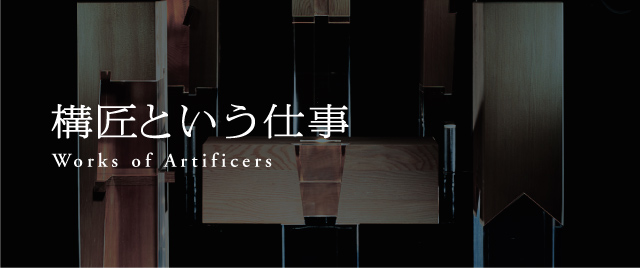



「構匠(こうしょう)」って何ですか?
ひとことで言うなら「始めるきっかけをつくる人」です。
どんな現場も、そのプロジェクトに最もふさわしい土地と施主との出会いの瞬間があります。それこそが、立ち上がる建築の「構え」を決める。すなわち、デザインの根幹になる。その瞬間は、施主だけでは茫洋としていて掴めないし、設計者だけが土地を見に行ったとしても立ち上がってはこない。土地と施主、その運命的な出会いからしか生まれないものです。この瞬間を見逃さず、立ち会って記録し進行させるのが「構匠」の一番大事な仕事です。
この瞬間がなければ、プロジェクトは始まらない。
ここでいう施主とは、その施設の運営者(利用者)、土地の所有者、資金提供者です。この三者は、住宅などの場合は同じ人物であるケースもありますが、大きなプロジェクトになると、別々である場合が大半です。具体的な設計プランは、プロジェクトが進行するなかで、これらさまざまな立場の人のリクエストに応じて変化していくし、そうあるべきだと思っていますが、最初に記録した瞬間のことは大事に持ち続けなければならない。デザインの根幹となるものを、最後までブレずに貫き通すために「構匠」は存在するのです。
What is an artificer?
Briefly put, it is a person who creates opportunities for starting things.
On any building site, there is a moment when the land and the client come together in the most fitting way for the project in question. This above all determines the style of the buildings to be constructed; it forms the basis of the design. That moment is too limitless to be grasped by the client alone, and it cannot be recognized solely by the designer, even if he or she directly goes to observe the site. It is something that can only come about from the fateful encounter between the land and client. The most important task of the artificer is to witness, record and advance that moment without letting it slip away.
Without this moment, the project cannot begin.
Client here refers to the operator (user) of facilities, landowner, and/or provider of funds. These three parties may be the same person in the case of a house and so on, however, they are usually separate entities in the case of a large project. Concrete design plans should change according to the requests of people of such varied standpoints as a project advances, however, the originally recorded moment must continue to be valued and retained. The artificer is there to ensure that the basis of the design is maintained without fluctuating until the end.
「初めて聞く名前です。
具体的には何をするのですか?
いままでどこにもなかった言葉です。建築家、棟梁、プロデューサーなど、それに近い役割を担う肩書きはあったかもしれませんが、「構匠」はそこにはおさまりきらない職能です。
具体的には、プロジェクトに関わるモノ・コト全てをデザインします。使う材料、寸法を決めます。図面も引きますが、それらはすべて、一緒に仕事をする職人ありきで考えます。誰とつくるかは、質の高い場を創造するためにとても重要なことです。
デザイン、職人、材料のバランスを整え、施主を含めたひとつの「座」をつくり、現場をまとめあげていくのが「構匠」の仕事です。施主の向こうにいる、家族や会社のスタッフなどのリクエストも聞き、デザインに反映させ現場と施主をつなぎます。大事なことは、当初決めたデザイン通りに現場が動いているかを監督することではなく、当初の想定以上の世界をつくりあげられるように、関わるすべての人が120%の力を発揮できる環境をつくることです。そういう意味で「構匠」もまた「座」を支える職人のひとりであり、施主に現場を引き渡すまでの総責任者です。
こうしたことは、これまで僕自身がやってきたことではあるのですが、何と名乗ればいいのかわからなかった。しかし、名前のないものは共有することが難しい。編集工学者の松岡正剛さんとの出会いを通して、そこにあえて名前をつけてみようということになりました。
たくさんの対話を重ねるなかで、いただいたのが「構匠」という名前です。
This is the first time I heard this name.
Specifically, what does it entail?
It’s a new word. There have been similar job descriptions, for example, architect, master carpenter, producer and so on, however, the function of the artificer goes beyond these terms.
Specifically, the artificer designs all the objects and activities that are involved in a project. He or she determines the materials and dimensions to be used. Drawings are also used; however, the artificer realizes that these only exist thanks to the craftsmen who work together on the job. The question of with whom work is conducted is very important for creating a high-quality building site.
The job of the artificer is to balance design with artisans and materials in creating a “team” and unifying the building site. The artificer also listens to the requests of family members and company employees who are on the other side of the client and reflects their wishes in the design while acting as a bridge between the building site and client. Rather than simply supervising work to ensure that the building site moves according to the original design, the artificer creates an environment to ensure that all the people involved can exhibit 120% of their capacity in building a world that exceeds the original expectations. In that sense, the artificer is an artisan who supports the “team” and the person who takes overall responsibility until the site is handed over to the client.
This is what I have done until now, but I didn’t know how to define it before. However, it is difficult to share something that doesn’t have a name. It was only after I met the editorial engineer Seigo Matsuoka that I decided to apply this name.
Artificer is the name I arrived at after conducting extensive dialogue.
なぜ、そう考えるようになったのですか?
僕は建築家に憧れて、建築学科のある大学に入りました。そのなかで、大学4年から大学院2年までの3年間、毎月、淡路島の左官久住章さんの現場を見学させてもらう機会があり、図面や論文とは違うリアルに建築をつくる喜びに触れました。できあがった建築に漂う、なんとも言えない品格に感動しました。久住さんはひとつのスタイルに固執したりはしない。けれど完成したものには、筋の通った品格がある。こんなふうに、自分たちの想像をはるかに超えた質の高い場をつくりあげる、身体も頭も優れた人たちがいるのかと驚いたし、優れた職人たちとつくっていく現場そのものに惚れたんです。そのころから、僕自身がやりたいことは、建築家という職業ではなく、優れた職人とつくる喜びを、関わるすべての人と共有できる現場を生み出すことなのではないか、と思うようになりました。
そこが出発点となり、自分なりのやり方でその道を模索しながら進んできました。建築を取り巻く環境は、いま大きく変わってきています。これからますます「構匠」のような、場をつくる人材が必要とされていると実感しています。新しい言葉、新しい概念が浸透していくには、とても時間がかかると思います。僕の代では成し遂げられないほどに。それでも、後に続く人材を育て、魅力的な現場をつくり続けていけるよう、人生をかけて取り組んでいきたいと思っています。
How did you come to that conclusion?
Since I aspired to becoming an architect, I entered a university that had an architecture department. Over three years, between my fourth undergraduate year and during my two years of graduate school, I had the opportunity every month to observe building sites with the Awaji island plasterer Akira Kusumi, and this let me come into contact with the joy of making real architecture, rather than simply studying it in drawings and theory. I was moved by the indescribable dignity emanated by the finished buildings. Although Mr. Kusumi does not rigidly adhere to any one style, his finished works have a consistent dignity. I was surprised to discover there were people who were endowed with the outstanding physical and intellectual ability to create high-quality settings that far exceeded our expectations, and I fell in love with the building sites that are created with such skilled artisans. It was around this time that I started thinking that, rather than becoming an architect, I wanted to create building sites on which I could share with all persons concerned the joy of creating together with skilled artisans.
That became my starting point and since then I have progressed while groping for my own way. The environment surrounding architecture is now undergoing great change. I really feel that human resources such as artificers are needed to create work settings more than ever. It will take a long time for new terms and new concepts to permeate. It may not even happen in my own lifetime. Even so, I want to spend my life nurturing successors and continuing to create appealing building sites.
「構匠」に必要な能力とは何ですか?
意外にキャリアはいらないんですよ。あってもいいけど、手放さないと邪魔するので。瞬間を見逃さない集中力と、まじめに取り組む姿勢があれば十分です。
What skills does an artificer require?
Surprisingly, there is no need for a prior career. Having a career is good, but that can become a hindrance if it is not cast aside. All that is required is the concentration not to miss key moments, and a desire to work hard.





